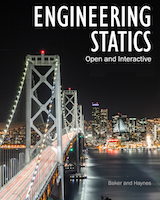Section 6.7 Summary
The various equilibrium topics we have covered and the associated problem-solving techniques are summarized below.
You should be able to recognize these situations, draw the associated free-body diagrams and solve for the unknowns of each case.
Particle Equilibrium.
An object may be treated as a particle when the forces acting on it are coincident, that is, all of their lines of action intersect at a common point. In this case, they produce no moment to rotate the object, and \(\Sigma \vec{M} = 0\) is not helpful. The applicable equation is
\begin{equation*}
\Sigma \vec{F} = 0\text{,}
\end{equation*}
which produces two scalar equations in two dimensions and three scalar equations in three dimensions.
Rigid Body Equilibrium.
A rigid body can rotate and translate so both force and moment equilibrium must be considered.
\begin{align*}
\Sigma \vec{F} \amp = 0\\
\Sigma \vec{M} \amp = 0
\end{align*}
In two dimensions, these equations produce two scalar force equations and one scalar moment equation. Up to three unknowns can be determined.
In three dimension, they produce three scalar force equations and three scalar moment equations. Up to six unknowns can be determined.
Trusses.
A truss is a structure that consists entirely of two-force members and only carries forces at the joints connecting members. Two-force members and loading at joints allow free-body diagrams of the joints to expose the axial loads in members.
In addition to the equations provided by treating the entire truss as a rigid body, each joint provides two additional equations for two-dimensional trusses, and three for non-planar trusses.
Frames and Machines.
Frames and machines are structures that contain multiple rigid body systems. Frames don’t move and are designed to support loads. Machines are generally designed to multiply forces and usually have moving parts. Both frames and machines can be solved using the same methods.
All interactions between bodies are equal and opposite action-reaction pairs.
When solving frames and machines
-
Two-force members provide one useful equilibrium equation and can determine one unknown.
-
In two dimensions, rigid bodies result in two scalar force equations and one scalar moment equation. Up to three unknowns can be determined.
-
In three dimensions, rigid bodies produce three scalar force equations and scalar three moment equations. Up to six unknowns can be determined.

